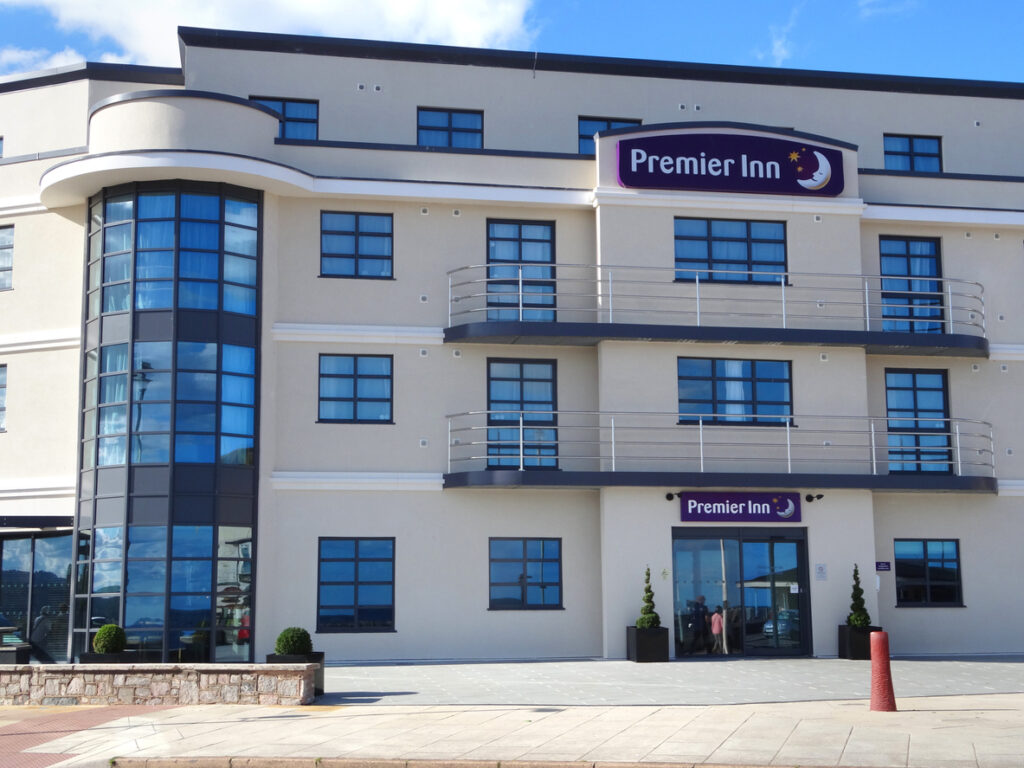In a recent decision handed down by Deputy High Court Judge Lance Ashworth KC on 29 August 2025, the High Court ruled on a trade mark battle between two giants in the hotel and holiday accommodation industry – easyGroup Limited v Premier Inn Hotels Limited [2025] EWHC 2229 (Ch).
In this case, the High Court dismissed easyGroup Limited’s (easyGroup) trade mark infringement claims against Premier Inn Hotels Limited (Premier Inn). This case teaches us important lessons about the court’s approach to trade mark infringement claims and points towards practical steps you can take to protect your brand in this landscape.
Background to the case – Why easyGroup took Premier Inn to court over ‘Rest Easy’
In 2021, Premier Inn launched its ‘Rest Easy’ marketing campaign, featuring the slogan ‘Rest Easy’ alongside the brand’s imagery of the crescent moon and purple colour.
easyGroup brought trade mark infringement claims against Premier Inn, alleging that Premier Inn’s use of the phrase ‘Rest Easy’ infringed the following of its trade marks:
- ‘EASYHOTEL’ and ‘easyHotel’ (word marks)
- ‘easy’ (stylised marks in orange Cooper Black font)
- ‘Rest Easy Apartments’ (word mark)
easyGroup claimed infringement of its registered trade marks by Premier Inn on the following two bases under the Trade Marks Act 1994:
- Infringement by use in the course of trade where there exists a likelihood of confusion on the part of the public because:
- an identical sign was being used in relation to goods or services which are similar to those for which the trade mark is registered; or
- a similar sign was being used in relation to goods or services which are identical or similar to those for which the trade mark is registered. (s10(2)).
- Infringement by use in the course of trade of an identical or similar sign where the registered trade mark has a reputation in the UK and the use of the sign takes unfair advantage of, or is detrimental to, the distinctive character or repute of the registered trade mark. (s10(3)).
The s10(2) claim – Was there likelihood of confusion between ‘Rest Easy’ and ‘Rest Easy Apartments’?
easyGroup claimed infringement under s10(2) in relation only to its ‘Rest Easy Apartments’ trade mark, on the basis that the marks were very similar and used in relation to identical or highly similar services, and that there existed a likelihood of confusion as a result.
In considering what constitutes ‘use in the course of trade’, the High Court defined this as use as a ‘badge of origin’. The High Court determined that, because ‘rest easy’ is a common English phrase, it was only used in the course of trade by Premier Inn when used in the Premier Inn ‘lock up’ (i.e. a consistent visual arrangement of brand elements).
Assessing the similarity of the marks takes into account the phonetic, visual and conceptual similarity to determine whether they would be perceived as similar by the average consumer. The High Court held that, whilst there was some aural and phonetic similarity, the presence of the word ‘Apartments’ in the easyGroup trade mark and the dominant components of the crescent moon imagery and Premier Inn name in the Premier Inn sign led to a finding of a low level of similarity.
Assessment of the similarity of services takes into account the uses of the service, the users of the service, the physical nature of the service, the trade channels and whether they are in competition with one another. The High Court determined that there was a medium level of similarity between the rental of apartment services covered by the Rest Easy Apartments trade mark and the hotel services provided by Premier Inn.
Ultimately, the High Court did not consider there to be a likelihood of confusion. The High Court emphasised the low level of distinctiveness in the ‘Rest Easy Apartments’ trade mark and commented again that Premier Inn’s use of ‘Rest Easy’ was within its ‘lock up’ and was dominated by the Premier Inn name and crescent moon imagery. Further, easyGroup had not presented any evidence of actual confusion. Whilst a lack of such evidence is not fatal, the High Court noted that the longer the use complained of has gone on in parallel to the trade mark, the more significant it is. The previous owners of the ‘Rest Easy Apartments’ trade mark had used this for almost 4 years alongside Premier Inn’s use of the slogan ‘Rest Easy’ and yet no evidence of confusion had materialised.
The s10(2) claim was therefore dismissed.
The s10(3) claim – Did Premier Inn take unfair advantage of easyGroup’s reputation?
easyGroup claimed infringement under s10(3) in relation to the ‘EASYHOTEL’ and ‘easyHotel’ word marks and the ‘easy’ stylised marks.
As with the s10(2) claim, the High Court held that Premier Inn’s use of ‘Rest Easy’, when ‘locked up’ in Premier Inn’s branding, was use in the course of trade.
The s10(3) claim does not require proof of a likelihood of confusion, but rather proof of unfair advantage of or detriment to the distinctive character or repute of the trade mark. Here, the High Court found that there was a lack of reputation or distinctiveness in the relevant services and that association with other brands in the easyGroup family (e.g. easyJet and easyCar) was insufficient to remedy this.
Further, the High Court held that there was a very low level of similarity between the marks and no conceptual similarity in the mind of the average consumer.
The High Court further found that easyGroup had not established a detriment nor that Premier Inn were taking unfair advantage. Rather, Premier Inn were launching a rebrand by way of fair competition. The High Court considered that easyGroup were seeking “illegitimately to prevent such competition, by claiming exclusivity of the word “easy” in the hotels sphere”, which was contrary to the interests of customers.
As such, the s10(3) claim was also dismissed.
Tactical move- – easyGroup’s acquisition of the trade mark ‘Rest Easy Apartments’ for use in the infringement claim.
It is a fairly common tactic for parties to look to acquire an additional or an earlier right in order to gain an advantage in litigation.
In this case, once litigation had already been initiated by easyGroup, easyGroup acquired the trade mark ‘Rest Easy Apartments’ and amended its claim to include the infringement of this trade mark.
On the face of it, this would look to strengthen easyGroup’s argument that Premier Inn’s use of the phrase ‘Rest Easy’ constituted an infringement, given the similarity between these word marks.
However, the High Court noted that the former owner of the ‘Rest Easy Apartments’ trade mark had not asserted any infringement by Premier Inn. Further, despite 4 years of parallel use of the ‘Rest Easy Apartments’ trade mark by the previous owners and the ‘Rest Easy’ slogan by Premier Inn, there was no evidence of actual confusion in the minds of customers. This would seem to undermine easyGroup’s position that such infringement had, in fact, taken place.
Further, easyGroup themselves had never taken litigious action against the previous owner of the ‘Rest Easy Apartments’ trade mark. This served to undermine easyGroup’s argument that, in its use of the ‘Rest Easy’ slogan, Premier Inn had infringed its other trade marks (namely the ‘EASYHOTEL’ and ‘easyHotel’ word marks and the ‘easy’ stylised marks). easyGroup seemed to be arguing that Premier Inn’s use of ‘Rest Easy’ was an infringement of its ‘EASYHOTEL’, ‘easyHotel’ and ‘easy’ trade marks, but that the previous use of ‘Rest Easy Apartments’ had not been.
When considering litigation tactics, it is important to consider the whole picture and ensure consistency between the argument put forward and the actual use of the trade marks.
The future for easyGroup’s claims
In a press release following the decision, easyGroup’s creator and owner, Sir Stelios, commented that the judgment was “ridiculous” and that he is confident that the decision will be overturned. He stated that the decision threatens the value of intellectual property assets and that, if unchallenged, he may as well start a new business called “Premier Hotels” and would “get away with it”.
The decision is subject to appeal, which easyGroup have made clear they will be pursuing.
As one in a long line of trade mark infringement claims made by easyGroup, it remains to be seen whether easyGroup will be successful in this battle with Premier Inn and also how far they will go to defend their ‘easy’ family of brands.
How to protect your brand and avoid trademark disputes
- Risk management – Stress-test new branding against existing trade marks to guard against possible infringement action being taken against you.
- Assess distinctiveness – Generic or idiomatic phrases are difficult to protect under a trade mark unless they have acquired distinctiveness through consistent and/or stylised use.
- Consideration of your ‘lock up’ – There is a distinction made where marks are used within the ‘lock up’ that distinguishes the use from other uses. There will be a lower risk of an infringement claim against you if marks are used within your brand’s ‘lock up’, particularly if your other branding is more distinctive (such as the Premier Inn name and crescent moon imagery).
- Family of brands – Be mindful that distinctiveness in some of your brands may not automatically confer the same to other brands within the same family.
- Carefully consider strategic acquisitions – Acquiring new trade marks can serve to strengthen your litigation position but be careful this doesn’t inadvertently undermine your case.
Expert advice
From building your intellectual property portfolio to combating infringement of the same, it is best to seek expert advice to ensure your brand and reputation is protected.
Should you be looking to take proactive protective steps or need advice on litigation, our experienced Commercial Services Team would be happy to assist.






